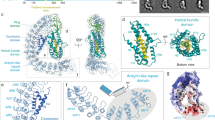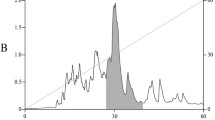Abstract
Cone snails (Conus) elaborate a series of conotoxin (CTX) peptides in their venoms to paralyze their prey. Among these toxins, ω-CTX’s specifically target to presynaptic voltage-gated calcium channel subsets, causing inhibition of neurotransmitter release. ε-CTX SO3 was isolated from the venom ofConus striatus, which is the only available fish-hunting snail near the coast of the South China Sea. The three-dimensional solution structure of ω-CTX SO3, a peptide which is the only ω-conotoxin reported to show high homology with another ω-CTX (MVIIA fromC. Magus), has been determined by1H NMR techniques. The molecular structure of ω-CTX SO3 is stabilized by three disulfide bridges and a short triple-stranded antiparallel β-sheet with four turns. A comprehensive comparison suggested that the backbone conformation of ω-CTX’s was quite conserved, while the length of β-sheet and the type of some turns might have minor differences.
Similar content being viewed by others
References
Adams, M. E., Olivera, B. M., Neurotoxins—overview of an emerging research technology, Trends Neurosci., 1994, 17(4): 151–155.
Olivera, B. M., McIntosh, J. M., Cruz, L. J. et al., Purification and sequence of a presynaptic peptide toxin from Conus geographus venom, Biochem., 1984, 23: 5087–5090.
Olivera, B. M., Milijanich, G. P., Ramachandran, J. et al., Calcium channel diversity and neurotransimitter release: the ω-conotoxins and ω-agatoxins, Annu. Rev. Biochem., 1994, 63: 823–867.
Lu, B. S., Yu, F., Zhao, D. et al., Conopeptides from conus striatus and conus textile by cDNA cloning, Peptides, 1999, 20(10): 1139–1144.
Kohno, T., Kim, J., Kobayashi, K. et al., Three-dimensional structure in solution of the calcium channel blocker ω-conotoxin MVIIA, Biochem., 1995, 34(32): 10256–10265
Basus, V. J., Nadasdi, L., Ramachandran, J. et al., Solution structure of ω-conotoxin MVIIA using 2D NMR spectroscopy, FEBS Letters, 1995, 370(3): 163–169
Davis, J. H., Bradley, E. K., Miljanich, G. P. et al., Solution structure of ω-conotoxin GVIA using 2-D NMR spectroscopy and relaxation matrix analysis, Biochem., 1993, 32(29): 7396–7402.
Sevilla, P., Bruix, M., Santoro, J. et al., Three dimensional structure of ω-conotoxin GVIA determined by1H NMR, Biochem.Biophys. Res. Commun., 1993, 192(3): 1228–1244.
Fair-Jones, S., Miljanich, G. P., Nadasdi, L. et al., Solution structure of ω-conotoxin MVIIC, a high affinity ligand of P-type calcium channels, using1H NMR spectroscopy and complete relaxation matrix analysis, J. Mol. Biol., 1996, 448(1): 106–124.
Nemoto, N., Kubo, S., Yoshida, T. et al., Solution structure of ω-conotoxin MVIIC determined by NMR, Biochem. Biophys. Res. Commun., 1995, 207(2): 695–700.
Civera, C., Vázquez, A., Sevilla, J. M. et al., Solution structure determination by two-dimensional1HNMR of ω-conotoxin MVIID, a calcium channel blocker peptide, Biochem. Biophy. Res. Commun., 1999, 254(1): 32–35.
Nielsen, K. J., Thomas, L., Lewis, R. J. et al., A consensus structure for ω-conotoxin with different selectivities for voltage-sensitive calcium channel subtypes—comparision of MVIIA, SVIB and SNX-202, J. Mol. Biol., 1996, 263(2): 297–310.
Kobayashi, K., Sasaki, T., Sato, K. et al., Three-dimensional solution structure of ω-conotoxin TxVII, an L-type calcium channel blocker, Biochem., 2000, 39(48): 14761–14767.
Yan, Y. B., Luo, X. C., Zhou, H. M. et al., Two-state kinetics characterized by image analysis of nuclear magnetic resonance spectra, Chinese Sci. Bull., 2002, 47(5): 389–393.
Zhou, Y. R., Liu, F. Y., Dai, Q. Y. et al., Optimization of synthetic and folding conditions of a novel w-conotoxin peptide SO3, Lett. Biotechnol. (in Chinese), 2002, 13(4): 286–288.
Wuthrich, K., NMR of Proteins and Nucleic Acids, New York: John Wiley & Sons, 1986.
Wüthrich, K., Billeter, M., Braun, W., Pseudo-structures for the 20 common amino acids for use in studies of protein conformations by measurements of intramolecular proton-proton distance constraints with nuclear magnetic resonance, J. Mol. Biol., 1983, 169: 949–961.
Pardi, A., Billeter, M., Wüthrich, K., Calibration of the angular dependence of amide proton-C-alpha proton coupling constants,3Jhnα in a globular protein—Use3Jhnα for identification of helical secondary structure, J. Mol. Biol., 1984, 180: 741–751.
Güntert, P., Braun, W., Wüthrich, K., Efficient computation of three-dimensional protein structures in solution form nuclear magnetic resonance data using the program DIANA and the supporting programs CALIBA, HABAS and GLOMSA, J. Mol. Biol., 1991, 217: 517–530.
Hewage, C. M., Jiang, L., Parkinson, J. A. et al., Solution structure of a novel ETB receptor selective agonist ET1-21 [Cys(Acm)1,15, Aib3,11, Leu7] by nuclear magnetic resonance spectroscopy and molecular modeling, J. Peptide Res., 1999, 53(3): 223–233.
Richardson, J. S., The anatomy and taxonomy of protein structure, Adv. Protein Chem., 1981, 34: 167–339.
Wilmot, C. M., Thornton, J. M., β-turns and their distortions: a proposed new nomenclature, Protein Eng., 1990, 3: 479–493.
Sibanda, B. L., Blundell, T. L., Thornton, J. M., Conformation of b-hairpins in protein structures: a systematic classification with applications to modelling by homology, electron density fitting and protein engineering, J. Mol. Biol., 1989, 206: 759–777.
Flinn, J. P., Pallaghy, P. K., Lew, M. J. et al., Role of disulfide bridges in the folding, structure and biological activity of wconotoxin GVIA, Biochimica et Biophysica ACTA, 1999, 1434(1): 177–190.
Li, Z., He, X. P., Xie, Z. P. et al., Effect of new O-superfamily conotoxin SO3 on sodium and potassium currents of cultured hippocampal neurons, Brain Research, 2003, 965: 155–158.
Author information
Authors and Affiliations
Corresponding author
Additional information
Atomic coordinates for the 11 converged structures of ω-conotoxin SO3 have been deposited with the Protein Data Bank, Brookhaven National Laboratories, Long Island, NY 11973, under the accession code 1FYG.
About this article
Cite this article
Yan, Y., Tu, G., Luo, X. et al. Three-dimensional solution structure of ω-conotoxin SO3 determined by1H NMR. Chin.Sci.Bull. 48, 1097–1102 (2003). https://doi.org/10.1007/BF03185760
Received:
Accepted:
Issue Date:
DOI: https://doi.org/10.1007/BF03185760




